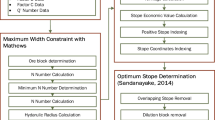Abstract
The analysis of algorithms to optimize the geometry of the stope limits in underground mines is performed on the block orebody models, and its results are reported. The scopes of application of the existing methods and algorithms are given.
Similar content being viewed by others
REFERENCES
M. Ataee-pour, “A heuristic algorithm to optimise stope boundaries,” Ph.D. Thesis, University of Wollongong, Australia (2000).
J. M. Riddle, “A dynamic programming solution of a block-caving mine layout,” in: Proceedings of the 14th International APCOM Symposium, SME, Colorado (1977).
T. B. Johnson and W. R. Sharp, “A three-dimensional dynamic programming method for optimal ultimate open pit design,” USBM Report of Investigation, No. 7553 (1971).
J. Deraisme, C. de Fouquent, and H. Fraisse, “Geostatistical orebody model for computer optimization of profits from different underground mining methods,” in: Proceedings of the 18th International APCOM Symposium, The Inst. of Mining and Metallurgy (1984).
J. Deraisme and C. de Fouquent, “Recent and future developments of “downstream” geostatistics,” Geostatistics and National Resource Characterisation, Eds: Verly et al. (1984).
N. M. Cheimanoff, E. P. Deliac, and J. L. Mallet, “GEOCAD: an alternative CAD artificial inteligence tool that helps moving from geological resources to mineable reserves,” in: Proceedings of the 21st International APCOM Symposium, SME, Colorado (1989).
C. Alford, “Optimization in underground mine design,” in: Proceedings of the 25th International APCOM Symposium, The Australasian Institute of Mining and Metallurgy, Melbourne (1995).
B. M. Davis and J. Morrison, “Enhanced underground design through optimization and risk assessment,” in: Proceedings of the 28th International APCOM Symposium, Ed.: K Dagdelen, Colorado (1999).
J. Ovanic and D. S. Young, “Economic optimization of stope geometry using separable programming with special Branch and Bound techniques,” in: Proceedings of the 3rd Canadian Conference on Computer Applications in the Mineral Industry, Ed.: H S Mitri, Balkema, Rotterdam (1995).
J. B. Creegan and F. A. Monforte, “Southern California Gas Company uses special ordered sets to model regulatory guidelines,” Interfaces, 20, No.4 (1990).
J. Ovanic and D. S. Young, “Economic optimization of open stope geometry,” in: Proceedings of the 28th International APCOM Symposium, Ed.: K Dagdelen, Colorado School of Mines, CO (1999).
M. Ataee-pour, “A new heuristic algorithm to optimise stope boundaries,” in: Proceedings of the 2nd Regional APCOM Symposium, Ed.: L. A. Puchkov, Moscow, Russia (1997).
Author information
Authors and Affiliations
Additional information
__________
Translated from Fiziko-Tekhnicheskie Problemy Razrabotki Poleznykh Iskopaemykh, No. 5, pp. 62–82, September–October, 2005.
Rights and permissions
About this article
Cite this article
Ataee-pour, M. A Critical Survey of the Existing Stope Layout Optimization Techniques. J Min Sci 41, 447–466 (2005). https://doi.org/10.1007/s10913-006-0008-9
Received:
Issue Date:
DOI: https://doi.org/10.1007/s10913-006-0008-9



